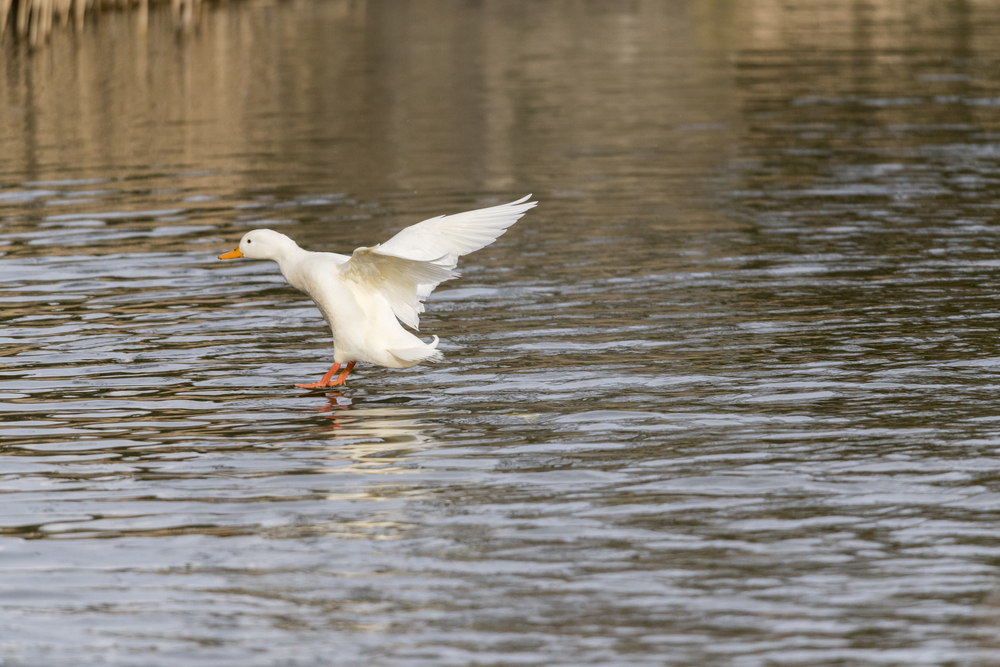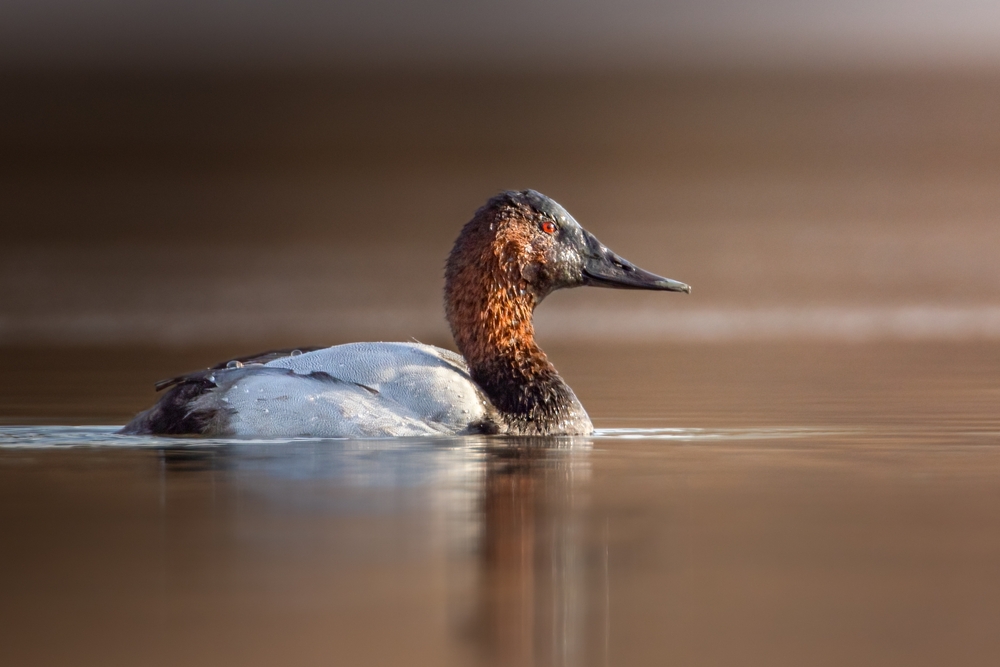The Domestic Duck is a direct descendant of the Mallard (Anas platyrhynchos). Most domestic breeds trace back to wild mallards, though Muscovy Ducks (Cairina moschata) form a separate domesticated lineage.
About
The Domestic Duck (Anas platyrhynchos domesticus) is a domesticated form of the wild Mallard, belonging to the family Anatidae. First domesticated in Asia thousands of years ago, domestic ducks have since spread worldwide, bred for food, eggs, feathers, and companionship. Today, they are found in farms, homesteads, city parks, and rural ponds, displaying a wide variety of sizes, colors, and temperaments depending on breed and purpose.
Domestic ducks are generally medium-sized waterfowl, though size varies widely between breeds, from the small Call Duck to the large Pekin. Unlike the wild Mallard, which has a fairly standard plumage pattern, domestic ducks exhibit a wide spectrum of colors, from pure white to iridescent greens, browns, and even spotted or patterned varieties. Most retain the characteristic flattened bill and webbed feet that make ducks efficient dabblers and swimmers.
Their diet is omnivorous, consisting of grains, aquatic vegetation, insects, and small invertebrates. On farms, they are often fed balanced grain-based diets but also forage naturally when allowed access to ponds or fields. Domestic ducks are excellent for controlling insects and weeds, making them useful additions to agricultural systems.
Reproduction depends on breed and management. While some domestic ducks can breed naturally, others, especially those heavily bred for size, may require human assistance in incubation. Clutches typically contain 5–15 eggs, and ducklings hatch after about 28 days. Domestic ducks generally do not migrate, though they retain many instincts of their wild ancestors, including strong flocking behavior.
Over centuries of breeding, domestic ducks have become less flight-capable than wild Mallards, with many breeds unable to fly at all. Despite this, they are hardy, adaptable, and valued worldwide for their contributions to human food and culture. Their quacking calls, graceful swimming, and approachable nature also make them familiar and beloved animals in both rural and urban settings.
Physical Characteristics
The Domestic Duck (Anas platyrhynchos domesticus) is the domesticated form of the Mallard, selectively bred over thousands of years for meat, eggs, and ornamental traits. Its appearance varies widely depending on breed, but some shared features define the species.
Head & Bill:
Heads range from sleek and narrow to broad and rounded depending on breed. Bills are generally wide and flat, ranging in color from yellow to orange to black.
Plumage:
Plumage is highly variable. Some breeds retain wild-type mallard markings (iridescent green head, white neck ring, chestnut breast), while others display solid white, buff, black, pied, or patterned feathers. Selective breeding has created ornamental varieties with unusual colors, frills, or crests.
Body & Wings:
Domestic ducks tend to be heavier and stockier than wild mallards, with shorter wings relative to body size, which reduces flying ability. Wings are functional but many breeds are poor fliers.
Tail:
Tails are short and often slightly upturned. Drakes (males) may show a curled “sex feather” at the tail tip.
Legs & Feet:
Short legs with strong, webbed feet placed slightly rearward for paddling. Leg and foot color can be orange, yellow, or dark depending on breed.
Size:
-
Length: 20 to 26 in (50 to 65 cm) depending on breed
-
Weight:
-
Lightweight breeds: 3 to 5 lbs (1.4 to 2.3 kg)
-
Heavyweight breeds: 8 to 15 lbs (3.6 to 6.8 kg)
-
-
Wingspan: about 26 to 32 in (66 to 81 cm)
Domestic ducks’ physical characteristics reflect both their wild mallard ancestry and centuries of human-directed selection, producing an array of forms from small egg-laying breeds to large, heavy-bodied meat breeds.
Reproduction
The Domestic Duck (Anas platyrhynchos domesticus) follows the mallard pattern—small to medium clutches, ~4-week incubation, precocial young—shaped by breed selection and human management.
Mating and Courtship
Drakes court with head-bobs, tail-wags, and soft calls. In managed flocks, a 1:5–1:8 drake-to-duck ratio maintains fertility. Some commercial lines also use artificial insemination for consistency.
Breeding Season
Peak fertility is late winter through summer in temperate regions, extended year-round under artificial light and steady nutrition.
Nesting
Hens choose a sheltered, dry spot (nest box or ground hollow) and pull down feathers to line a shallow cup. Many egg-layer breeds have reduced broodiness; broody breeds (e.g., Muscovy—not the same species) or incubators are often used.
Eggs
Typical natural clutch 8–15 eggs (production breeds may lay far more across a season). Eggs are cream to white; average mass ~65–90 g depending on breed.
Incubation
Mallard-derived domestic ducks: 26–28 days. (Note: domestic Muscovy ducks, Cairina moschata domestica, incubate ~35 days.) Hens with good broodiness sit tightly; otherwise, eggs are machine-incubated and turned multiple times daily.
Hatch and Brooding
Ducklings hatch with open eyes and dense down. They can walk and swim within hours. Under hens or heat lamps, brooding temperature is gradually reduced over 3–4 weeks.
Feeding the Young
Ducklings self-feed from day one on starter crumbles; access to shallow water for dabbling aids feeding but must be supervised to prevent chilling.
Fledging and Independence
Wing feathers develop over 7–10 weeks (lighter breeds sooner, heavy breeds later). Young are fully independent once feathered and weather-hardy.
Special Notes
-
Crosses between mallard-derived ducks and Muscovies produce sterile “mule” ducks.
-
Selective breeding for eggs or meat can trade off broodiness and parental care, making incubation and brooder management central to domestic duck reproduction.
Lifespan
The Domestic Duck (Anas platyrhynchos domesticus) has longevity shaped more by management than by genetics, with care, housing, and purpose (pet, farm, or commercial) driving outcomes.
Lifespan with Good Backyard/Farm Care
Typically 8–12 years when provided balanced nutrition, clean water for dabbling (not necessarily swimming), predator-proof housing, and routine veterinary care. Lighter breeds often reach the upper end; heavy meat breeds trend shorter.
Commercial/Production Settings
Commonly 1–3 years due to early culling once egg or meat productivity declines, not because of biological limits.
Feral or Poorly Managed Conditions
Often 2–5 years, with higher losses from predation, disease, harsh weather, and limited feed.
Key Factors That Influence Longevity
-
Nutrition: Proper protein and adequate niacin for ducklings; avoiding obesity in adults.
-
Water & Hygiene: Clean water for dabbling and bill rinsing prevents eye, nostril, and mouth issues; dry, clean bedding reduces infection.
-
Foot & Leg Health: Soft, dry footing and appropriate body weight reduce bumblefoot and joint strain (especially in heavy breeds).
-
Predation & Safety: Secure night housing against foxes, raccoons, dogs, raptors; safe pond access to prevent entanglement or chilling.
-
Disease Prevention: Clean feeders/waterers, biosecurity, and prompt care for parasites, respiratory disease, botulism risks, or avian influenza exposure.
-
Environmental Stress: Shade and ventilation in heat; draft-free, dry shelter in cold and wet conditions.
With thoughtful husbandry—diet, hygiene, foot care, and predator protection—domestic ducks can live near their biological potential and remain productive and healthy for many years.
Eating Habits
The Domestic Duck (Anas platyrhynchos domesticus) is an adaptable omnivore whose feeding style blends grazing on land with dabbling and filter-feeding in shallow water.
Diet
Balanced rations (starter/grower/layer feeds) plus natural foods: grasses and clover, grains and seeds, aquatic plants (duckweed, pondweed), and invertebrates (snails, slugs, insects, worms, small crustaceans). Occasional vegetable trimmings and forage crops are readily taken.
Foraging Strategy
Primarily a dabbler. Ducks skim the surface or tip-up in shallow water, sweeping side-to-side and straining food with fine lamellae along the bill. On land, they graze short swards and probe soft soil or leaf litter.
Filter-Feeding Mechanics
Water and mud are sucked in; the tongue and lamellae sieve out edible bits while excess water drains from the sides of the bill. Sensitive bill nerves help locate hidden seeds and invertebrates.
Water & Grit
They must have water deep enough to dunk the entire bill while eating—this aids swallowing, keeps nares clean, and reduces choking risk. Small grit in the gizzard grinds fibrous plants and whole grains.
Daily Rhythm
Most active at dawn and dusk. In warm weather they browse intermittently, resting to preen and bathe between feeding bouts. Night feeding increases where they feel secure.
Seasonal/Age Shifts
-
Ducklings: higher-protein starter and adequate niacin support bone/leg development; they also pick at tiny insects.
-
Laying hens: greater calcium and steady energy intake; more plant matter and invertebrates during peak lay.
Social Feeding
Usually feed in groups, following bolder individuals to new patches. Dominant birds may crowd preferred trays; multiple stations reduce competition.
Energy Demands & Notes
Energy needs rise during molting, cold snaps, and egg production. Avoid low-nutrition “treats” (e.g., bread); offer varied greens, safe garden weeds, and access to clean water to support natural dabbling behavior and overall health.
Uniqueness
The Domestic Duck (Anas platyrhynchos domesticus) is shaped by thousands of years of human selection, producing traits uncommon in wild ducks.
One species, many breeds
From lightweight egg layers (e.g., Runners) to heavyweight meat birds (e.g., Pekin), selective breeding yields wide differences in size, posture, plumage, and productivity.
Reduced flight
Heavier bodies, shorter wings relative to mass, and relaxed selection for migration make most breeds poor fliers—an advantage for care and containment.
High egg output
Top laying lines can exceed 250–300 eggs/year, far surpassing wild mallards; fertilization is only needed for hatching, not for laying.
“Drake feather” & voice dimorphism
Males often show a curled tail feather and a soft, raspy call; females give the classic loud “quack,” aiding quick sex identification.
Color and crest variety
Domestic lines display white, buff, pied, penciled, and iridescent patterns; the heritable crested trait produces a pom-pom of feathers on the head.
Water-ready anatomy
Dense, water-repellent plumage, an active preen (oil) gland, and finely toothed lamellae along the bill enable efficient filter-feeding and grooming.
Calm temperament & imprinting
Selection favors tractable birds. Ducklings readily imprint on caregivers, strengthening human–animal bonds in farm and pet settings.
Hybridization & feralization
Domestic ducks freely interbreed with wild mallards, influencing local gene pools; escapees can establish feral park pond populations.
Muscovy crosses are sterile
Crosses with domestic Muscovy (Cairina moschata domestica) produce mule ducks—vigorous but sterile, useful for meat production.
Working birds
Beyond eggs and meat, many keep ducks for slug and pest control, manure for gardens, and down feathers—practical roles uncommon in wild counterparts.
Be the First to Share Photos of This Species.
FAQ’s
1. What species is closest to the Domestic Duck?
2. How does the Domestic Duck compare to other ducks?
Compared to wild ducks, domestic ducks are generally heavier, stockier, and poorer fliers due to selective breeding. They also produce far more eggs and show greater plumage variety.
3. What national parks provide the best opportunities for seeing a Domestic Duck?
Domestic ducks are not tied to wilderness parks like wild species. They are most often found in urban parks, farm ponds, and managed wetlands worldwide. Some national parks with historic farms or heritage sites, such as Colonial National Historical Park (Virginia, USA) or Cuyahoga Valley National Park (Ohio, USA), may keep domestic ducks as part of cultural or agricultural demonstrations.




































































